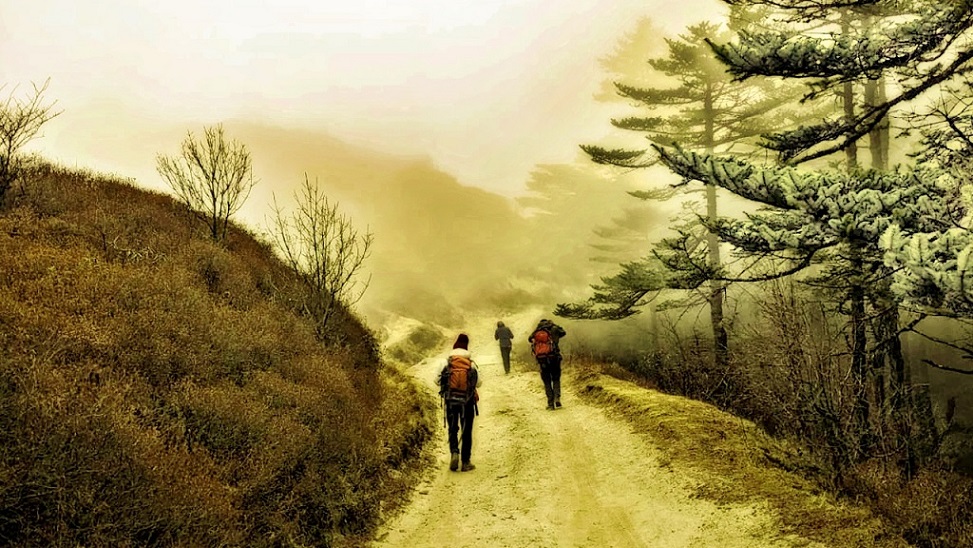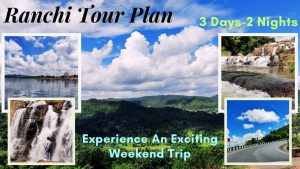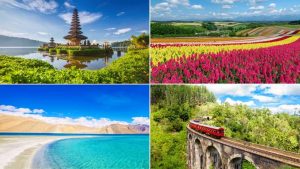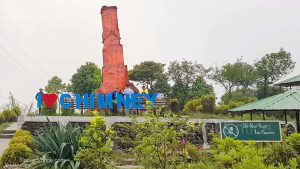Do you ever feel stressed and overwhelmed by the daily hustle and bustle of city life and constant reminder of the next day’s deadlines at the workplace? Do you ever wish to leave behind all the artificial concrete structures, the mechanical noises, and the polluted air at least for a few days? Do you ever think about getting rid of the competitive mindset and the chaos of complicated thoughts all around you at the workplace or otherwise? If so, the Sandakphu Trek could be the perfect escape for you.
Imagine being alone in the mountains, surrounded by nothing but the serenity of nature. Even in the sub-zero temperatures of the harsh winter, the Sandakphu Trek offers a chance to disconnect from the world and reconnect with yourself. As you embark on this journey, you’ll leave behind the busy nature of city life, your work pressure, and all kinds of electronic buzz. Instead, you’ll be welcomed by the enchanting sound of singing birds, the rustling of leaves in the wind, and the stunning views of the mighty Himalayas.
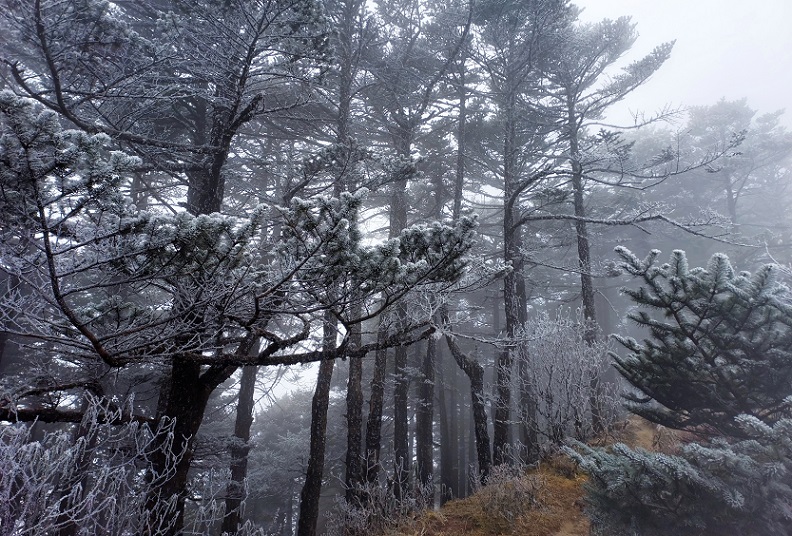
As you hike through the rugged terrain and climb to the summit, you’ll often find yourself in a small cottage at night, nestled in the mountains. This is the perfect place to relax and unwind, surrounded by nothing but pure nature. There’s no internet, no phone calls, and no next-day deadline — you are just surrounded by the pristine natural beauty. This is your chance to truly escape from the chaos of daily life and find inner peace.
Let me share my Sandakphu trek experience, exploring the enchanting Himalayas and the beauty of being alone in the mountains.
Itinerary (Sandakphu Trek)
This is a beginner-level trek in the Eastern Himalayas. The destination is Sandakphu, which is the highest peak in West Bengal (3636 meters).
| Day | Starting point | Final point | How to | Distant | Time |
|---|---|---|---|---|---|
| Day-1 | NJP/Bagdogra | Chitrey (via Maneybhanjang) | Car | 100 Km | 4-5 h |
| Day-2 | Chitrey | Tumling (via Meghma) | Trek | 9 km | 6 h |
| Day-3 | Tumling | Kalapokhri (via Gairibas) | Trek | 12 km | 7 h |
| Day-4 | Kalapokhri | Sandakphu | Trek | 6 km | 3-4 h |
| Day-5 | Sandakphu | Timburey (via Gurdum) | Trek | 15 km | 6-7 h |
| Day-6a | Timburey | Srikhola road head | Trek | 2 km | 1 h |
| Day-6b | Srikhola road | NJP/Bagdogra (via Maneybhanjang) | Car | 150 km | 6-7 h |

Let’s begin the Journey – the trek toward Sandakphu
After reaching NJP Railway station, you have to reach ManeBhanjan – the starting point of this trek route. Usually, the NJP-Manebhanjan cab is arranged by the trekking organizations.
In case, you are arranging the trek by yourself, you can book a private cab from NJP Railway station or Bagdogra Airport to Manebhajan (around ₹4000) or a shared cab (around ₹500 per person).
My journey was a little different; I already reached Darjeeling 2 days before the trekking date. So, on that day, I had to reach Manebhanjan by 1 pm for all the paperwork as well as to join our little trekking group.
Simply, I took a shared cab from the Darjeeling cabstand that cost only ₹100 to leave me at Manebhanjan.
Day 1 – Manebhanjan to Chitrey
The first day of the Sandakphu trek begins with paperwork and offloading the backpack at the Himalayan Trekkers office in Mane Bhanjan. After completing all the necessities and receiving the trekking poles, you are set to start the journey; if you follow my trek route, the first-night halt will be at Chitrey.
We could start at 2 pm; the journey initiated with a 2.5 km steep incline that took us around 2 hours to complete.
As we set off on the hike, we were greeted by a cloudy and foggy day, which is typical for the mountains in the afternoon. The clouds started rolling in around 1 pm in the mountains, which is a common occurrence.

The trail mostly passes aside the road, although sometimes you need to cross the road to follow the trekker-specific routes. Initially, you may not reveal the joy of natural trailing, but it is easier for beginners. Also, it’s ideal for those who prefer avoiding too many steep inclinations.
As we just started trekking upward through the lush green mountains, we took our time and went slow.
Note: If you are a beginner, it’s suggested to drink plenty of water and stay close to the guide, who provides helpful tips and encourages along the way.
Despite the cloudy conditions and the hardships of steepness of the terrain, the fresh mountain air was invigorating, and we found ourselves taking deep breaths and feeling rejuvenated.
After 2 hours of nonstop trekking, we comfortably reached Chitrey at 4 pm.
We, the group of 6, spent the evening in a relaxing mood, gossiping in the dining space, having tea, coffee, snacks, etc., until the dinner was ready. The accommodation wasn’t equipped with luxurious amenities (it is common at hills), but the dining space was a warm and cozy place to relax and socialize with our fellow trekkers.
As the trek progressed, the altitude increased, and the temperature dropped, making it too cold to go outside in the evenings. So, anytime the dining space is the most relaxing place in evening.
Note: For our trip, dinner was included in the package, except for chicken which was an extra charge. Hot water was sent to the rooms on demand, though it cost extra 50 rupees. There were no room heaters, but we were cozy with the thick blankets provided. Taking bath is not recommended at all, as the locals mentioned 3 people died in past after taking bath in full winter.
Must read: Double Decker Root Bridge – An Awesome Trek Experience into the Forest of Cherrapunji
Day 2 – Chitrey to Tumling via Meghma
The second day of the Sandakphu trek began with a mesmerizing sunrise at Chitrey. The entire valley bathed in golden light as the first rays of the sun hit the earth, evolving a breathtaking scene. The special appearance of magnificent Kanchanjunga mountain range at the backdrop made the whole frame iconic.

In the morning session, it’s worth visiting nearby Buddhist monastery, which is one of the local attractions of Chitrey. The serenity and peaceful atmosphere of the monastery added to the overall spiritual experience of the trek.
As you hike across the hills, visiting one Buddhist stupa after another, you’ll feel a deep sense of tranquillity and connection to pure nature.
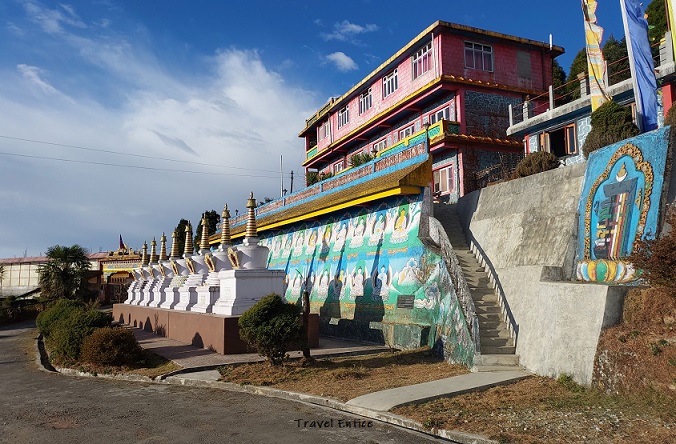
After breakfast, we left for the Tumling. When we were leaving the monastery, we were greeted by some beautiful furry mountain dogs. Although they were stray, they were very intelligent, healthy, and friendly. Some of them gave us companionship throughout the whole trail, leading the way!
The trail from Chitrey to Tumling via Meghma covers a 9 km long trek route that takes about 5-6 hours to complete (depending on your pace). The trail consists of several ups and downs, though it was not extremely steep.
On the way, you’ll meet a few military checkpoints where your guide will complete the paperwork.
On the trek route from Chitrey to Meghma, we came across a small pond (pond locally called ‘Pokhri’) that was a Buddhist religious site. As mentioned by the guide, during monsoon the whole area gets covered with water.

The trek can get quite hot in the daytime, even in December; so it is recommended to wear light clothes inside, otherwise, you may get very sweaty sometimes.
When we reached Meghma at about 1 PM, it was very cloudy and cold. We halted at a small restaurant where the food was already prepared for us (because it was pre-ordered).
Here, you can buy some local wine made from the extraction of rhododendron flowers; trying this thing may be a unique experience.

After the meal, we set out towards Tumling. The weather was still cloudy and cold, but the trek was not too challenging. We took our time and enjoyed the natural beauty of the area.
When you trek towards Tumling, you are already inside Nepal and as such, no mobile network or internet is available there. The roads are mostly made of boulders. On the way, you’ll find a few streams of water flowing down from the high mountains; these are the main source of water for the locals living downhill.
During peak winter, the trees and grassland become dry and rough; also, the rhododendron flowers disappear, making the mountains a barren land. Despite the harshness of the winter, the natural beauty of the area still remains breathtaking! However, breathing the pollution-free pure air is ever-refreshing.
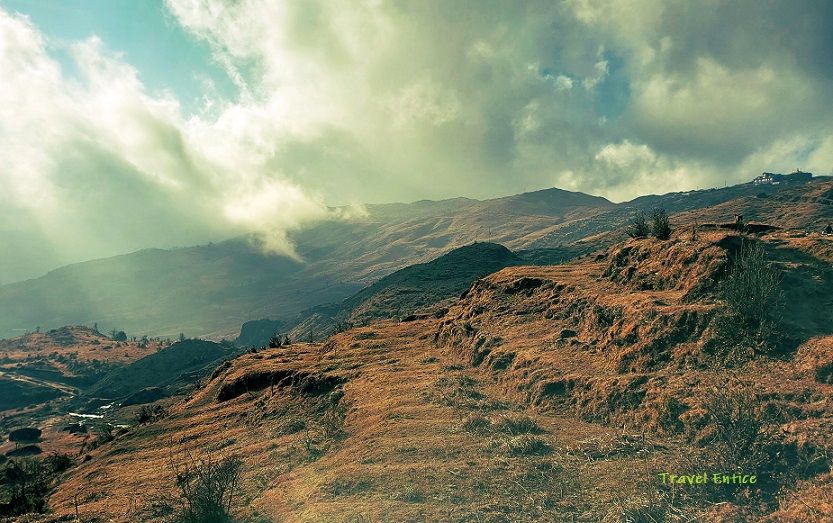
We reached Tumling at around 4 pm, just before sunset. Tumling is a small township situated at the India-Nepal border; the separation by the road is clearly visible from Tumling.
The accommodations depend on the booking made by the trekking organization. If you plan the trek by yourself, you are suggested to pre-book your stay. At Tumling, we were accommodated in a huge dormitory.
It is always a good idea to start the trek early so that you can reach Tumling before sunset, as the sunset is another beautiful phenomenon of Tumling. You can spend the evening enjoying the sunset, exploring the area, and meeting locals.

With the disappearance of daylight, the temperature drops rapidly at Tumbling. It remains sub-zero at night and you can see how the water streams get frozen with time.
As always, we spent the evening in the dining space with tea and snacks, sometimes hovered outside to feel the charm of real cold, and do some phone calls at home.
Note: This is the last place where you’ll get proper network; you’ll barely get any mobile network in the next two days. So, better you should complete your necessary phone calls from Tumling.
At night, the clouds move downhill due to the cold atmosphere at the top. As a result, the sky becomes crystal clear, offering the magical sight of unexplored universe; it’s a heaven full of millions stars, twinkling with all their glory.
After dinner, we went to bed early. In the mountains, it’s always better to sleep early so that you can wake up in the first morning to witness the sunrise.
Related: Heavenly Gurudongmar Lake at Sikkim
Day 3 – Tumling to Kalipokhri via Gairibas
Day 3 of the Sandakphu trek began early, as our guide woke us up to show us the sunrise. Right from our dormitory, we could see the sunlight below the horizon on one side and the silhouette of the Kanchanjunga on the other.
We quickly dressed up and moved towards the viewpoint to feel the real thrill and of course, to have some iconic photo snaps.
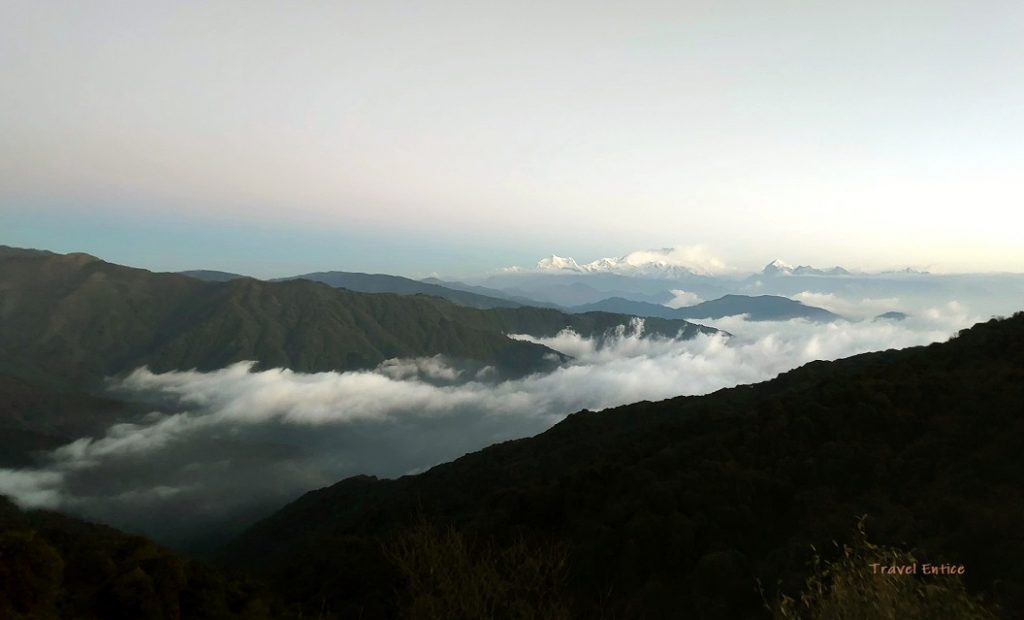
The valley at the bottom was completely covered with motionless clouds, but we could see the crystal-clear morning sky converting red; the Reciprocal fall of sunrays on mountain picks, covered Mt. Kanchanjunga with a golden glow! Such a magnificent sight kicked off the pinching cold of morning wind; we kept witnessing the live glory of magical sunrise.
The breakfast at Tumbling was a bit different; it was a local recipe with both rice and local bread. However, it’s nothing less than exceptional for someone who loves to try new dishes.
Our next stop of the Sandakphu trek was at Kalipokhri via Gairibas. We started hiking even higher. In this route, the trail follows the Nepal-West Bengal border most of the time. It’s a 12 km long hike that takes about 7 hours (based on your pace).
On the way, you can see the Sleeping Buddha almost all the time as you’ll be getting closer to the mountain range.

The trail to Sandakphu is mostly around Singalila National Park, so you’ll see plenty of green vegetation across the board. On the way you’ll see, Dhotrey and Kanchenjunga on the right and the Everest and Annapurna range on left. The guide man describes all about the mountain ranges as you move further.
The trail isn’t very steep, but it’s a long hike, so you are suggested to take time and go slow. Our guide had already suggested us not to waste too much time, taking pictures or resting; this day covers the longest distance in the entire Sandakphu trek. It is always ideal to reach the destination before sunset.
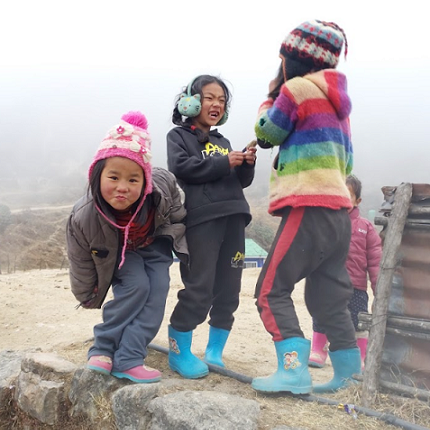
We reached Gairibas at about 1:30 pm and the clouds started to cover everything as usual. We met some cute little local kids there, had noodles at lunch, and moved on toward Kalipokhri.
The trail to Kalipokhri is a mix of uphill and downhill hiking. As we hiked downhill, the trail was getting cloudy and foggy.
On the way, you’ll see a lot of red panda awareness signboards. Red pandas are endangered species, and the forest department blocks some of the trails during the winter as it is their mating season.
When we reached Kalipokhri, it was extremely cold and windy, and the sun was almost on the horizon. We were completely exhausted after a 12 km long hike. So, after settling into our accommodation, we took some rest and then join the gossip table at dining hall. Meanwhile, the local people made a fireplace nearby, so we didn’t miss any chance to warm ourselves.
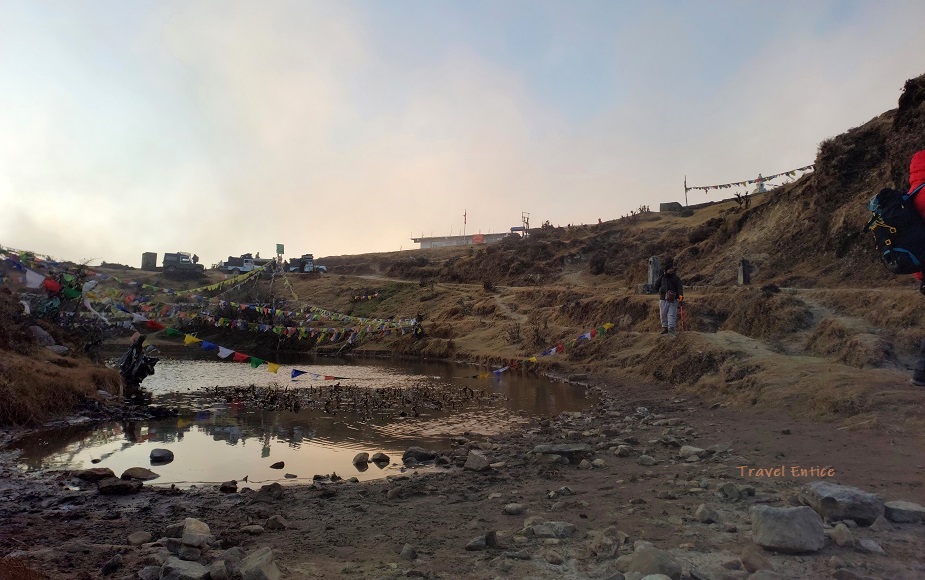
The hike to Kalipokhri is challenging, but the natural beauty of the area and the opportunity to explore versatile animal species make the journey worthwhile. Despite the lack of luxurious facilities, you can feel the comfort of home at the rest house with the peaceful surroundings of Kalipokhri.
May find interesting: Simanadara: A Hidden Heaven Where Mountains Meet the Valley
Day 4 – Kalipokhri to Sandakphu
Day 4 of the Sandakphu trek began early as our guide woke us up again for the sunrise. The whole valley was covered by clouds; remarkably, the water streams were completely frozen in the morning. Part of the Pokhri (pond) was also frozen. Certainly, the temperature the last night dropped to -4oC!
Although the mountains were covered by the nearby higher peaks, the sunrise was still exquisite.

After breakfast, we moved on to the next hiking journey toward our final spot, Sandakphu.
This final trek route is comparatively short but very steep. Our guides prepared us psychologically by informing us about this fact.
As you start moving upward, the temperature starts dropping rapidly. After a challenging steep uphill journey, you’ll reach the zero point.
After reaching zero point, It was a sigh of relief for us as we thought we reached the peak, but as we turned the other way, it was another 20 minutes of steep hiking to the hotel.
We reached Sandakphu quite early, at around 12:30 pm. The sky was still clear as the altitude was fairly high (3600 m) there.
You may read: Tandrabong or Tendrabong: The Offbeat Wonder of North Bengal
Moments of the day in Sandakphu
Situating atop the mountain peak, Sandakphu boasts plenty of viewpoints, offering the exclusive closer view of the entire mountain range. You can spend your fairy time by exploring nearby viewpoints and snapping some exceptional photos of the Sleeping Buddha (Mt. Kanchanjungha).

The after-lunch session is ideal to spend under the sun; it helps you to cope with the sudden extreme cold because of the altitude increase.
In evening, you can visit a viewpoint called Ahal Point and witness the sunset scene standing behind the glass.
For reaching this point from the hotel, we had to walk 30 minutes across the hilly path; the wind was pinching the skin like nonsense needles. Fortunately, the viewpoint was well-equipped with a glass enclosure, which was made to enjoy the sunset seamlessly without feeling windy cold. We really enjoyed the whole scene standing behind the glass, snapped some great pictures of the sunset and the mountain ranges, and then we returned.
When were returning, it was dark and we almost lost our way, but eventually, we followed a local dog the whole path under the clear sky. Finally, we reached the hotel like a miracle!
Here, you can try some local organic drink called Tumba (made of fermented millet), if you like. Your guide may help you to find it.
The scarcity of electricity and water is common at Sandakphu. But it’s a great trade-off between a little bit of inconvenience and a wonderful experience that would stay with you for a lifetime. The lack of modern amenities and luxuries might make you appreciate the natural beauty of the place, even more intensely.
Love beach adventure? – Plan A Trip to Mousuni Island: Uncover the Hidden Gem of South Bengal
Day 5 – Sandakphu to Timburey via Gurdum
The fifth day of the Sandakphu trek started with the early morning sunrise. We went to the nearby viewpoint just before the reel started.
As always, it was a mesmerizing view but we were more surprised to see a snowy morning! A thin layer of snow covered everything that we could see, except the sun! Certainly, the whole valley turned into the land in heaven!
The locals said that was the first snowfall of the year; unfortunately, it came when we were hovering in dreamland at midnight and missed it fairly.
The return journey to Timburey was the last part of our Sandakphu trek; A feeling of nostalgia grabbed us all. it’s time to say “Goodbye Sandakphu”.
After breakfast, when we started the return trek, it was still snowy everywhere; the widespread white landscape added an extra delight to the day’s trek experience.
The trail from Sandakphu to Timburey is a steep downhill and a fairly long journey, which takes the whole day. You have to hike across the Singalila forest, so you can enjoy lots of greenery; also, the route is mostly covered with lush green. As usual, the temperature starts increasing as you move downwards.
Note: For those with heavier body or knee problems, it is recommended to use knee caps as hiking downwards for 5-6 hours can cause severe pain.

We stopped near Gurdum River; the lunch was arranged at the youth hostel lodge. And by far, this was the best lunch in the whole journey.
The after-lunch trail mostly passed beside Gurdum River. On the way, we met a beautiful waterfall. The absolute silence of the surroundings let us hear the waterfall from far away, offering an enchanting atmosphere inside the deep forest.
We reached Timburey at 4 pm. It was a nice accommodation, a much better one compared to the previous stays. In the evening, the guide man arranged a bonfire with music and dance, and of course, some drinks. After all, it was the final night we were staying together.
A happy journey should be ending up with a bit of fun, as it was!

Day 6 – Timburey to Srikhola & Return
The next morning, we had a nice breakfast. It included Tibetan bread which was delicious and new to us.
The final part of the Sandakphu trek is pretty smooth. If you start the day from Timburey, first you have to hike down to Srikhola bridge. It takes about 1 hour. Then book a cab for NJP railway station or Bagdogra airport via Mane Bhanjan.
We had our reserved car waiting at Srikhola. By this car, first we directly went to Mane Bhanjan; then picked up the stuff we had offloaded before. Next, we had another 4 hours of journey on the same car to NJP railway station.
So, that is all about the Sandakphu trek experience.
Below, I have included some important information, which may help you to plan the Sandakphu Trek perfectly.
Must Read: Netarhat — The Queen of Chhotanagpur
Expenses for the Sandakphu trek (per person)
The overall package costs around ₹11000-13000 (depending on accommodation). Expenditure per person can vary from ₹100-₹500 per day depending on individual spending habits.
Apart from that the cost to reach the base location from NJP station or Bagdogra airport might cost ₹4000 for reserved car or ₹500 per person in shared cab.
On the last day, the return trip from Srikhola to NJP railway station or Bagodra airport costs around ₹6000 for reserved car. Shared cab is available from SukhiaPokhri which costs around ₹500-₹600 per person. To reach SukhiaPokhri from Srikhola, a cab needs to be reserved, which may cost around ₹1500.
Contract No. of Sandakphu trek arrangers: +919XXXXXXX27
Have you ever been at: Kakolem Beach? Explore The Absolute Virgin Beauty of South Goa!
The ideal time for Sandakphu Trek
You can plan a Sandakphu trek in two specific seasons in a year:
Winter (November to February)
November and early December are the safest for winter travelers due to optimum weather conditions in this season. The chances of rain and snowfall are also minimal in Nov-Dec. Snowfall starts in late December. The snowfall can make the trekking journey magical, but at the same time, the guides won’t allow continuing the trek if the weather is too bad. The temperature can drop up to -10oC at night.
Spring (March to June)
The weather remains perfect in this season. The trails and the mountains become covered with beautiful rhododendron flowers. The temperature never be sub-zero or extremely low.
Don’t miss exploring: the 14 Best spots in Coonoor Hill Station
Food and Lodging on Sandakphu Trek
None of the trekkers’ staying locations are primary/ commercial tourist spots. So, don’t expect any sort of luxurious accommodation. Also, with the increasing altitude, the transportation charges for bringing food and other amenities increase reciprocally. As a result, food prices tend to rise at higher altitudes.
Nevertheless, the hotels, lodges, and homestays lie on the Sandakphu trek route fairly fulfill the minimum necessities that you need for spending each night in a cold atmosphere.
Room heaters are not available in most of the places on the trek route, as electricity is not abundant on the mountain and in Nepal as well.
At Sandakphu, mobile or any other device charging points are not available, as the single source of electricity is the solar panels there.
Love relaxing on the top beach? Must visit Palolem: Also Meet the ultimate spirit of Canacona
Water crisis at Sandakphu!
Water is readily available in most places except for Sandakphu. In the mountains, the primary source of water is the waterfalls or downward streams that are sourced from the mountaintop. However, Sandakphu itself is the highest peak in West Bengal; for that reason, there is no direct water source.
Also, the temperature can be sub-zero during winter, hence the water in the pipelines gets frozen. For the same reason, most toilets do not have any water supply lines. The water needs to be carried to the toilet when you need.
Foods in Sandakphu Trek route
You shouldn’t expect delicious dishes on the days of Sandakphu trek.
Foods that you’ll get readily available are:
- Snacks
- Biscuits
- Noodles
- Chow
For dinner and lunch, rice is available at most places with pulses and simple vegetables. Eggs or chicken might cost extra. Chicken is even unavailable in some places.
Sometimes momo, chupri, or Tibetan bread, or some local foods are provided by the local lodging authorities or homestay owners.
Alcohol beverages are not readily available; if you are habituated, it is recommended to buy the alcohol before starting the journey. A local drink called ‘Tumba’ may be tried with the help of the guide.
Also enjoy: Holidays in Rishop
Wrapping up
the Sandakphu trek is an amazing experience that I recommend to any beginner-level trekker looking for an adventure in the Himalayas. The natural beauty of the mountains, the challenge of the trek, and the company of new friends make this journey one that we would always treasure.
We, a group of new friends met first time on this trek, and returned home with lots of beautiful memories that would last for a lifetime.
Before the journey started, we were a bit skeptical, to be honest! We revealed the upcoming challenges of Sandakphu trek; it’s not just about the physical challenge, but it also initiates the mental and emotional challenge of being away from the comforts of city life.
However, the trek helped us to appreciate the natural beauty of the world, to be more self-sufficient, and to get connected to pure nature in a way that we never experienced before.

The Sandakphu Trek is an opportunity to break free of the constant distraction of technology and reconnect with yourself and unexplored nature. It’s a journey that will challenge you physically and mentally, but the rewards are worth it.
If you have any further queries about Sandakphu trek, don’t hesitate to drop your question in the comment box below. I’ll be more than happy to help you.
Have a nice trek!
Dipankar Das
Mr. Dipankar Das is a Software Engineer by profession, presently working at Deloitte. Apart from his regular job, he is blessed with several extracurricular activities. Weekend painting is one of his favorite hobbies, while traveling is his biggest love. His long holidays never passed inside the enclosed door, but he loves to fly and explore new destinations.

